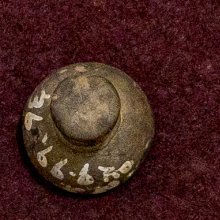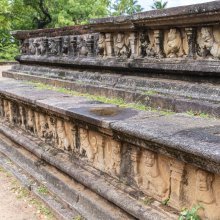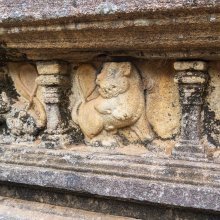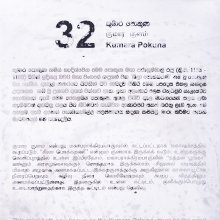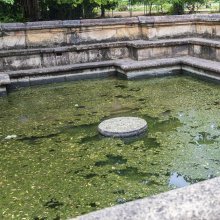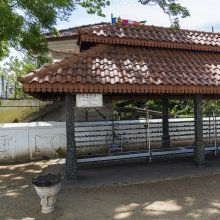Cila, Cilā, Cilà, Cīlā: 7 definitions
Introduction:
Cila means something in Hinduism, Sanskrit, Marathi, Hindi, biology, Tamil. If you want to know the exact meaning, history, etymology or English translation of this term then check out the descriptions on this page. Add your comment or reference to a book if you want to contribute to this summary article.
Alternative spellings of this word include Chila.
Images (photo gallery)
(+8 more images available)
In Hinduism
Vyakarana (Sanskrit grammar)
Source: Wikisource: A dictionary of Sanskrit grammarCila (चिल).—The sign of the aorist (लुड् (luḍ)) for which generally सिच् (sic) and अङ्, क्स, चङ् (aṅ, ksa, caṅ) and चिण् (ciṇ) are substituted in specified cases; cf. P. III. 1. 43-66.

Vyakarana (व्याकरण, vyākaraṇa) refers to Sanskrit grammar and represents one of the six additional sciences (vedanga) to be studied along with the Vedas. Vyakarana concerns itself with the rules of Sanskrit grammar and linguistic analysis in order to establish the correct context of words and sentences.
Biology (plants and animals)
Source: Google Books: CRC World Dictionary (Regional names)Cila in Nigeria is the name of a plant defined with Rottboellia cochinchinensis in various botanical sources. This page contains potential references in Ayurveda, modern medicine, and other folk traditions or local practices.
Example references for further research on medicinal uses or toxicity (see latin names for full list):
· Journal of Cytology and Genetics (1985)
· Nova Graminum Genera (1779)
· Cytologia (1986)
· Boletim da Sociedade Broteriana (1887)
· Tentamen Florae Abyssinicae … (1850)
· Cytologia (1989)
If you are looking for specific details regarding Cila, for example diet and recipes, pregnancy safety, extract dosage, health benefits, chemical composition, side effects, have a look at these references.

This sections includes definitions from the five kingdoms of living things: Animals, Plants, Fungi, Protists and Monera. It will include both the official binomial nomenclature (scientific names usually in Latin) as well as regional spellings and variants.
Languages of India and abroad
Marathi-English dictionary
Source: DDSA: The Molesworth Marathi and English Dictionarycilā (चिला).—m (Properly cirā) A strip of cloth with lines of gold thread, forming a turban.
--- OR ---
cīla (चील).—f A particular esculent vegetable.
--- OR ---
cīla (चील).—f R (For cīra) A longitudinal opening; a cleft, chink, cranny, fissure: also a long and narrow chasm, lane, pass.
--- OR ---
cīḷa (चीळ).—f Sudden spurting forth of milk (from the breast or udder). v phuṭa.
Source: DDSA: The Aryabhusan school dictionary, Marathi-Englishcīḷa (चीळ).—f Sudden spurting forth of milk.
Marathi is an Indo-European language having over 70 million native speakers people in (predominantly) Maharashtra India. Marathi, like many other Indo-Aryan languages, evolved from early forms of Prakrit, which itself is a subset of Sanskrit, one of the most ancient languages of the world.
Hindi dictionary
Source: DDSA: A practical Hindi-English dictionaryCīla (चील) [Also spelled chil]:—(nf) a kite; —[jhapaṭṭā] a sudden (kite-like) swoop, a snap; a boy’s game; —[ke ghoṃsale meṃ māṃsa kahāṃ] lit to look for meat in a kite’s nest—to seek for something in a quarter where it is bound to be used up.
...
Kannada-English dictionary
Source: Alar: Kannada-English corpusCīla (ಚೀಲ):—[noun] a non-rigid container made of fabric, paper, leather, etc., with an opening at the top that can be closed, with or without a handle; a sack, pouch or bag.
Kannada is a Dravidian language (as opposed to the Indo-European language family) mainly spoken in the southwestern region of India.
Tamil dictionary
Source: DDSA: University of Madras: Tamil LexiconCila (சில) noun < சின்-மை. [sin-mai.] [K. kela, M. cila.] Some, a few; சின்மையானவை. சிலசொல்ல றேற்றாதவர் [sinmaiyanavai. silasolla rerrathavar] (திருக்குறள் [thirukkural], 649).
--- OR ---
Cīlā (சீலா) noun
1. A sea-fish attaining 5 ft. in length, Sphyraena jello; ஐந்து அடி நீள முள்ள கடல்மீன் வகை. [ainthu adi nilagesi mulla kadalmin vagai.]
2. A basket or bag for baling out bilge-water from a boat; படகின் இறைகூடை. [padagin iraigudai.] (W.)
3. A water-bird; நீர்வாழ் பறவைவகை. [nirvazh paravaivagai.] (W.)
Tamil is an ancient language of India from the Dravidian family spoken by roughly 250 million people mainly in southern India and Sri Lanka.
See also (Relevant definitions)
Starts with (+151): Cilaa, Cilaan-ari, Cilabila, Cilabilahata, Cilabilata, Cilabilaunu, Cilabilla, Cilacalata, Cilacaram, Cilacatanam, Cilacattu, Cilacayacceti, Cilacayam, Cilacila, Cilacila, Cilacilai, Cilacilana, Cilacilata, Cilada, Cilaghola.
Ends with (+20): Acila, Amcecila, Bagalucila, Cilacila, Cilacila, Dronaka-cila, Erecila, Garbhacila, Gonicila, Guhecila, Hasibecila, Hegalucila, Himmanicila, Himmannicila, Hucila, Kacila, Kaicila, Kalcila, Kalucila, Kharcila.
Full-text (+141): Shila, Cilalekai, Cilavankam, Bagalu, Cicchila, Cilalikitam, Cilacatanam, Dronaka-cila, Cikchuki, Cilanakam, Silauta, Tatiyancila, Cilavarsham, Cil, Pakatattabhikkhu, Shalagrama-shila, Cilamilika, Cilanancu, Cilameni, Cilavairam.
Relevant text
Search found 106 books and stories containing Cila, Chila, Cilā, Cīla, Cīḷa, Cilà, Cīlā, Seelaa, Sila; (plurals include: Cilas, Chilas, Cilās, Cīlas, Cīḷas, Cilàs, Cīlās, Seelaas, Silas). You can also click to the full overview containing English textual excerpts. Below are direct links for the most relevant articles:
Buddhist Monastic Discipline (by Jotiya Dhirasekera)
Chapter VI - The New Role of Sila in Buddhist Monasticism
Chapter VIII - The Codified Law of the Sangha
Chapter IV - The Foundations of Monastic Life (sila, sikkha and sikkhapada)
Buddhist Education in Thailand (critical study) (by Smitthai Aphiwatamonkul)
6. Buddhist Ethics Provides room for a better tomorrow in Thailand < [Chapter 4 - Role of the Buddhist Education in The Thai Society]
6. Vinaya Rules: Life style of Buddhist monks < [Chapter 1 - Introduction]
7.2. The Phrapariyattidhamma: Study in the Form of Pali Course < [Chapter 2 - The Thai Sangha System of Education]
The history of Andhra country (1000 AD - 1500 AD) (by Yashoda Devi)
Part 33 - The Silas of Nandapura (A.D. 1350-1430) < [Chapter XIII - The Dynasties in South Kalinga]
Part 40 - End of the Sila (Silavamsi) dynasty < [Chapter XIII - The Dynasties in South Kalinga]
Part 37 - Gangaraju (A.D. 1427-1435) < [Chapter XIII - The Dynasties in South Kalinga]
Garga Samhita (English) (by Danavir Goswami)
Verse 4.19.102 < [Chapter 19 - A Thousand Names of Srī Yamunā]
Verse 4.19.122 < [Chapter 19 - A Thousand Names of Srī Yamunā]
Verse 5.13.17 < [Chapter 13 - The Arrival of Sri Uddhava]
Tiruvaymoli (Thiruvaimozhi): English translation (by S. Satyamurthi Ayyangar)
Section 7 - Seventh Tiruvaymoli (Cilam illac ciriyan) < [Book 4 - Fourth Centum]
Pasuram 5.1.3 < [Section 1 - First Tiruvaymoli (Kai ar Cakkarattu)]
Pasuram 2.3.8 < [Section 3 - Third Tiruvaymoli (Unil val uyire)]
In Asoka’s Footsteps (by Nina Van Gorkom)
